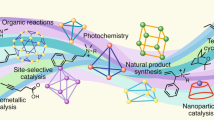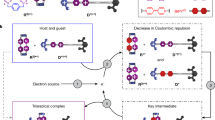Abstract
Supramolecular catalysis — the assembly of catalyst species by harnessing multiple weak intramolecular interactions — has, until recently, been dominated by enzyme-inspired approaches. Such approaches often attempt to create an enzyme-like 'active site' and have concentrated on reactions similar to those catalysed by enzymes themselves. Here, we discuss the application of supramolecular assembly to the more traditional transition metal catalysis and to small-molecule organocatalysis. The modularity of self-assembled multicomponent catalysts means that a relatively small pool of catalyst components can provide rapid access to a large number of catalysts that can be evaluated for industrially relevant reactions. In addition, we discuss how catalyst–substrate interactions can be tailored to direct substrates along particular reaction paths and selectivities.
This is a preview of subscription content, access via your institution
Access options
Subscribe to this journal
Receive 12 print issues and online access
$259.00 per year
only $21.58 per issue
Buy this article
- Purchase on Springer Link
- Instant access to full article PDF
Prices may be subject to local taxes which are calculated during checkout





Similar content being viewed by others
References
van Leeuwen, P. W. N. M. Supramolecular Catalysis (Wiley-VCH, 2008).
Ringe, D. & Petsko, G. A. How enzymes work. Science 320, 1428–1429 (2009).
Koblenz, T. S,. Wassenaar, J. & Reek, J. N. H. Reactivity within a confined self-assembled nanospace. Chem. Soc. Rev. 37, 247–262 (2008).
Pluth, M. D,. Bergman, R. G. & Raymond, K. N. Acid catalysis in basic solution: a supramolecular host promotes orthoformate hydrolysis. Science 316, 85–88 (2007).
Yoshizawa, M,. Tamura, M. & Fujita, M. Diels-Alder in aqueous molecular hosts: unusual regioselectivity and efficient catalysis. Science 312, 251–254 (2006).
Knowles, W. S. Asymmetric hydrogenation. Acc. Chem. Res. 16, 106–112 (1983).
Crabtree, R. H. Combinatorial and rapid screening approaches to homogeneous catalyst discovery and optimization. Chem. Commun. 1611–1616 (1999).
Goudriaan, P. E,. van Leeuwen, P. W. N. M,. Birkholz, M. N. & Reek, J. N. H. Libraries of bidentate phosphorus ligands; synthesis strategies and application in catalysis. Eur. J. Inorg. Chem. 19, 2939–2958 (2008).
Breit, B. & Seiche, W. Hydrogen bonding as a construction element for bidentate donor ligands in homogeneous catalysis: regioselective hydroformylation of terminal alkenes. J. Am. Chem. Soc. 125, 6608–6609 (2003).
Kamer, P. C. J,. van Leeuwen, P. W. N. M. & Reek, J. N. H. Wide bite angle diphosphines: Xantphos ligands in transition metal complexes and catalysis. Acc. Chem. Res. 34, 895–904 (2001).
Slagt, V. F,. van Leeuwen, P. W. N. M. & Reek, J. N. H. Bidentate ligands formed by self-assembly. Chem. Comm. 2474–2474 (2003).
Kuil, M. et al. Rigid bis-zinc(II) salphen building blocks for the formation of template-assisted bidentate ligands and their application in catalysis. Dalton Trans. 2311–2320 (2007).
Slagt, V. F,. van Leeuwen, P. W. N. M. & Reek, J. N. H. Multicomponent porphyrin assemblies as functional bidentate phosphite ligands for regioselective rhodium-catalyzed hydroformylation Angew. Chem. Int. Ed. 42, 5619–5623 (2003).
Takacs, J. M,. Reddy, D. S,. Moteki, S. A,. Wu, D. & Palencia, H. Asymmetric catalysis using self-assembled chiral bidentate P,P-Ligands. J. Am. Chem. Soc. 126, 4494–4495 (2004).
Rivillo, D. et al. Catalysis by design: wide-bite-angle diphosphines by assembly of ditopic ligands for selective rhodium-catalyzed hydroformylation. Angew. Chem. Int. Ed. 46, 7247–7250 (2007).
Reetz, M. T. Combinatorial transition-metal catalysis: Mixing monodentate ligands to control enantio-, diastereo-, and regioselectivity. Angew. Chem. Int. Ed. 47 2556–2588 (2008).
De Vries, J. G. & Lefort, L. The combinatorial approach to asymmetric hydrogenation: Phosphoramidite libraries, ruthenacycles, and artificial enzymes. Chem. Eur. J. 12, 4722–4734 (2006).
Liu, Y. et al. Hydrogen bonding makes a difference in the rhodium-catalyzed enantioselective hydrogenation using monodentate phosphoramidites. J. Am. Chem. Soc. 128, 14212–14213 (2006).
Sandee, A. J,. van der Burg, A. M. & Reek, J. N. H. UREAphos: supramolecular bidentate ligands for asymmetric hydrogenation. Chem. Commun. 864–866 (2007).
Meeuwissen, J,. Kuil, M,. van der Burg, A. M,. Sandee, A. J. & Reek, J. N. H. Application of a supramolecular-ligand library for the automated search for catalysts for the asymmetric hydrogenation of industrially relevant substrates. Chem. Eur. J. 15, 10272–10279 (2009).
Laungani, A. C. & Breit B. Supramolecular PhanePhos-analogous ligands through hydrogen-bonding for asymmetric hydrogenation. Chem. Commun. 844–846 (2008).
Li, Y,. Feng, Y,. He, Y.-M,. Chen, F,. Pan, J. & Fan, Q.-H. Supramolecular chiral phosphorous ligands based on a [2]pseudorotaxane complex for asymmetric hydrogenation. Tetrahedron Lett. 49, 2878–2881 (2008).
Breit, B. & Seiche, W. Self-assembly of bidentate ligands for combinatorial homogeneous catalysis based on an A–T base-pair model. Angew. Chem. Int. Ed. 44, 1640–1643 (2005).
De Greef, M. & Breit, B. Self-assembled bidentate ligands for the nickel-catalyzed hydrocyanation of alkenes. Angew. Chem. Int. Ed. 48, 551–554 (2009).
Chevallier, F. & Breit, B. Self-assembled bidentate ligands for Ru-catalyzed anti-Markovnikov hydration of terminal alkynes. Angew. Chem. Int. Ed. 45, 1599–1602 (2006).
Weis, M,. Waloch, C,. Seiche, W. & Breit, B. Self-assembly of bidentate ligands for combinatorial homogeneous catalysis: asymmetric rhodium-catalyzed hydrogenation. J. Am. Chem. Soc. 128, 4188–4189 (2006).
Slagt, V. F,. Röder, M,. Kamer, P. C. J,. van Leeuwen, P. W. N. M. & Reek, J. N. H. Supraphos: a supramolecular strategy to prepare bidentate ligands. J. Am. Chem. Soc. 126, 4056–4057 (2004).
Goudriaan, P. E. et al. Synthesis of building blocks for the development of the supraphos ligand library and examples of their application in catalysis. Eur. J. Org. Chem. 36, 6079–6092 (2008).
Jiang, X.-B. et al. Screening of a supramolecular catalyst library in the search for selective catalysts for the asymmetric hydrogenation of a difficult enamide substrate. Angew. Chem. Int. Ed. 45, 1223–1227 (2006).
Jiang, X.-B,. van Leeuwen, P. W. N. M. & Reek, J. N. H. SUPRAphos-based palladium catalysts for the kinetic resolution of racemic cyclohexenyl acetate. Chem. Commun. 2287–2289 (2007).
Kuil, M,. Goudriaan, P. E,. van Leeuwen, P. W. N. M. & Reek, J. N. H. Template-induced formation of heterobidentate ligands and their application in the asymmetric hydroformylation of styrene. Chem. Commun. 4679–4681 (2006).
Takacs, J. M. et al. Rhodium-catalyzed asymmetric hydrogenation using self-assembled chiral bidentate ligands. Pure Appl. Chem. 78, 501–509 (2006).
Moteki, S. A. & Takacs, J. M. Exploiting self-assembly for ligand-scaffold optimization: substrate-tailored ligands for efficient catalytic asymmetric hydroboration. Angew. Chem. Int. Ed. 47, 894–897 (2008).
Pignataro, L. et al. Combinations of acidic and basic monodentate binaphtholic phosphites as supramolecular bidentate ligands for enantioselective Rh-catalyzed hydrogenations. Eur. J. Org. Chem. 2539–2547 (2009).
Park, J,. Lang, K,. Abboud, K. A. & Hong, S. Self-assembled dinuclear cobalt(II)-salen catalyst through hydrogen-bonding and its application to enantioselective nitro-aldol (Henry) reaction. J. Am. Chem. Soc. 130, 16484–16485 (2008).
Ohshima, S,. Tamura, N,. Nabeshima, T. & Yano, Y. A rate-accelerating noncovalently assembled system for thiazolium-catalysed oxidative decarboxylation of pyruvate in chloroform-acetonitile. Chem. Commun. 712–713 (1993).
Ohsaki, K,. Konishi, K. & Aida, T. Supramolecular acid/base catalysis via multiple hydrogen bonding interaction. Chem. Commun. 1690–1691 (2002).
Clarke, M. L. & Fuentes, J. A. Self-Assembly of organocatalysts: fine-tuning organocatalytic reactions. Angew. Chem. Int. Ed. 46, 930–933 (2007).
Mandal, T. & Zhao, C.-G. Modularly designed organocatalytic assemblies for direct nitro-Michael addition reactions. Angew. Chem. Int. Ed. 47, 7714–7717 (2008).
Uraguchi, D,. Ueki, Y. & Ooi, T. Chiral organic ion pair catalysts assembled through a hydrogen-bonding network. Science 326, 120–123 (2009).
Šmejkal, T. & Breit, B. A supramolecular catalyst for regioselective hydroformylation of unsaturated carboxylic acids. Angew. Chem. Int. Ed. 47, 311–315 (2008).
Šmejkal, T. & Breit, B. A Supramolecular catalyst for the decarboxylative hydroformylation of α,β-unsaturated carboxylic acids. Angew. Chem. Int. Ed. 47, 3946–3949 (2008).
Diab, L,. Šmejkal, T,. Geier, J. & Breit, B. Supramolecular catalyst for aldehyde hydrogenation and tandem hydroformylation–hydrogenation. Angew. Chem. Int. Ed. 48, 8022–8026 (2009).
Usui, I,. Schmidt, S,. Keller, M. & Breit, B. Allylation of N-heterocycles with allylic alcohols employing self-assembling palladium phosphane catalysts. Org. Lett. 10, 1207–1210 (2008).
Šmejkal, T. & Breit, B. Self-assembled bidentate ligands for ruthenium-catalyzed hydration of nitriles. Organometallics 26, 2461–2464 (2007).
Breuil, P.-A. R,. Patureau, F. W. & Reek, J. N. H. Singly hydrogen bonded supramolecular ligands for highly selective rhodium-catalyzed hydrogenation reactions. Angew. Chem. Int. Ed. 48, 2162–2165 (2009).
Das, S,. Incarvito, C. D,. Crabtree, R. H. & Brudvig, G. W. Molecular recognition in the selective oxygenation of saturated C-H bonds by a dimanganese catalyst. Science 312, 1941–1943 (2006).
Author information
Authors and Affiliations
Corresponding author
Rights and permissions
About this article
Cite this article
Meeuwissen, J., Reek, J. Supramolecular catalysis beyond enzyme mimics. Nature Chem 2, 615–621 (2010). https://doi.org/10.1038/nchem.744
Published:
Issue Date:
DOI: https://doi.org/10.1038/nchem.744
This article is cited by
-
Highly stable Zn anodes enabled by molecular channel of zincophilic supermolecules with abundant lone-pair electrons
Science China Materials (2024)
-
Selective hydrogenation via precise hydrogen bond interactions on catalytic scaffolds
Nature Communications (2023)
-
A supramolecular metalloenzyme possessing robust oxidase-mimetic catalytic function
Nature Communications (2023)
-
Single-atom nanozymes towards central nervous system diseases
Nano Research (2023)
-
Advancement in supramolecular control of organic reactivity induced by cucurbit[n]urils
Journal of Inclusion Phenomena and Macrocyclic Chemistry (2023)



